Gross R., Sidorenko A., Tagirov L. Nanoscale Devices - Fundamentals and Applications
Подождите немного. Документ загружается.

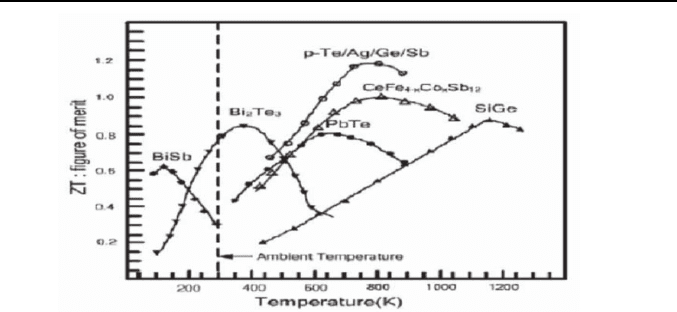
Thermoelectricity of Low-Dimensional Nanostructured Materials 295
The best room temperature cooling bulk materials available at present are
alloys of Bi
2
Te
3
with Sb
2
Te
3
such as Bi
0.5
Sb
1.5
Te
3
, p-type, and Bi
2
Te
3
with
Bi
2
Se
3
such as Bi
2
Te
2.7
Se
0.3
Thus the major objective in thermoelectric materials engineering and
investigation is to increase the figure of merit ZT =
σ
S
2
×T/K, i.e. to
increase electrical conductivity σ and thermoelectric power S, and to reduce
thermal conductivity K.
Basis of Improved Thermoelectric Efficiency in
Nanostructured Materials
Recently, thermoelectric materials research experienced a resurgence
inspired by the development of new concepts and principles to engineer
thermoelectric transport in low dimensional nanostructures. Extensive
investigations of thermoelectric properties of low-dimensional structures
started in the 1990’s after a seminal paper [3] of Hicks and Dresselhaus. In
parallel the interests in certain bulk thermoelectric materials such as
skutterudites and others have been renewed. The general approach in
developing new thermoelectric materials and structures can be succinctly
summarized as engineering of electron and phonon transport. Solid-state
nanostructured materials are unique in offering the possibilities of tailoring
both the quantum-mechanical and transport characteristics of electrons and
phonons through the artificial structure potential landscape.
Fig. 1. ZT vs T for established thermoelectric materials.
, n-type, with typical ZT values close to one [2].

296 V. G. Kantser
Being quantum quasi-particles the motion of electrons and phonons in
nanostructured materials can develop in the range between two different
regimes: i) totally coherent motion (when electrons or phonons spreads in
the structure as waves); ii) totally incoherent motion (when either or both of
them spreads in the structure as classical particles). The regime of the
transport processes in the structures are determined by the correlation
between size-scale of the structure potential landscape and three physical
length scales of the quasi-particles: mean free path (MFP), phase breaking
length (PBL) and the Fermi wavelength (FWL). In the terms of electron
parameters high values of ZT request both high mobility and high density of
states. This can be realized in anisotropic materials or in multivaley
semiconductors with anisotropic carrier characteristics, when it is possible
to have a small effective mass in the current flow direction to give a high
mobility and large effective masses in the directions perpendicular to the
current flow to give a high density of states. Thus, in comparison with the
usual electronic transport in traditional low dimensional structures, the
thermoelectric structures involve the factor of carrier anisotropy. At the
same time such structures are characterized by several groups of carriers in
different energy valleys and the possibility of band pocket engineering
occur, which together with anisotropy offer a new opportunity to tailor the
thermoelectric transport. Hence the above mentioned length scales in
thermoelectric solid state structures based on anisotropic and multivalley
semiconductors (such as bismuth (Bi) like semimetals, IV-VI narrow gap
semiconductors, n-type Si and Ge) MFP, PBL and FWL of the carriers
become anisotropic. Therefore, in addition to the issue of thermoelectricity
such structures open new possibilities for the investigation of traditional
low dimensional transport effects in situations where several groups of
carriers with anisotropic physical characteristics are present.
In the regime of coherent motion due to quantum size effects in
nanostructured materials, such as quantum wells, superlattices, quantum
wires, and quantum dots, the energy spectra of electrons and phonons can
be
manipulated through the variation of the size of the structures. Such
low-dimensional nanostructures can be considered to be new materials [2],
when a new set of size parameters provides a “new” material. Since the
constituent
components of nanostructures are well known, the structures
are suitable to a certain degree of analysis, prediction and optimization.
When the quasi-particle motion is incoherent, it is still possible to utilize
classical
size effects to tailor the transport properties providing for
example a more effective scattering of phonons at the boundaries and
interfaces
than of the charge carriers. In the context of structure boundaries
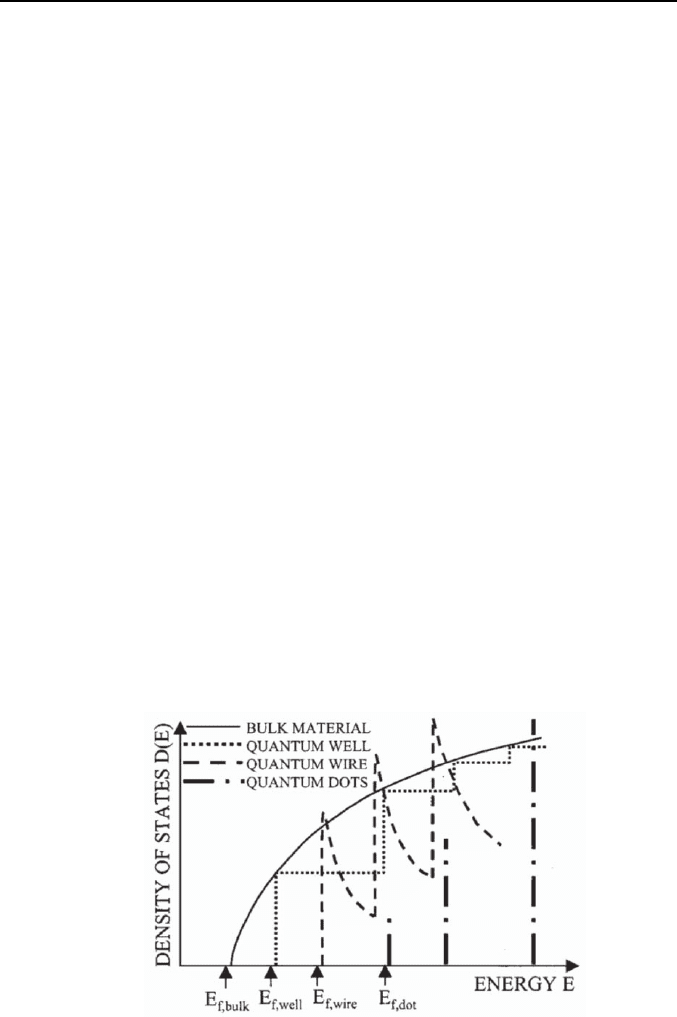
Thermoelectricity of Low-Dimensional Nanostructured Materials 297
and interfaces classical size effects can manifest themselves for charge
carriers too, leading to a stronger energy dependence of the carrier time
relaxation.
Thus we can mention the following two physical approaches to improve
the thermoelectric efficiency of low dimensional nanostructured materials:
I. ZT enhancement due to quantum confinement of carriers
- energy states engineering
- carrier pocket engineering
- band structure anisotropy engineering
- concentration of electronic density of states near Fermi energy
- semimetal – semiconductor transition
- increasing of energy asymmetry of electronic density of states
II. ZT increase due to a decrease in the lattice thermal
conductivity by phonon engineering
- increased phonon – boundary scattering: thickness W
≤
phonon MFP
- reduced phonon group velocity due to phonon confinement effect in
2D and 1D structures: L ~ W << MFP
-phonon stop-band materials
The main aspects of the transformation of the density of states due to the
change in the dimensionality of the electron system are illustrated in Fig. 2.
Fig. 2. The density-of-states of electrons in systems of different dimensionality.
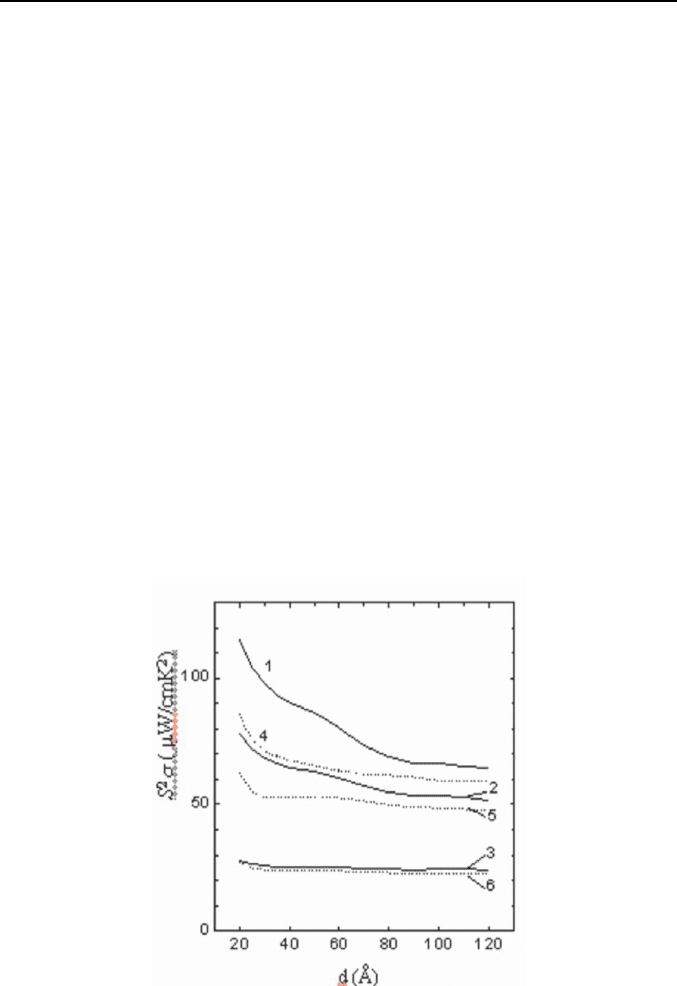
298 V. G. Kantser
Therefore it is challenging to develop new non-expensive methods of
fabrication of Bi
2
Te
3
and PbTe thermoelectric elements as well as to
improve significantly its and others materials like bismuth thermoelectric
performance, in particular on the basis of approaches for the nanoscale
driven enhancement of thermoelectric properties.
Multiple Quantum Well and Superlattice Layered
Structures
The engineering of electron states in nanostructures in the direction to
improve thermoelectric efficiency have started with the consideration of a
layered systems with multiple quantum wells [3] analyzing the transport
parallel to the layers. A large number of theoretical and experimental
papers have demonstrated the enhancement of
2D
ZT in the QW material of
n-type structures [4 - 7] due to electron confinement. Being one of the best
bulk thermoelectric materials lead telluride was among the first system
analyzed in the context of low dimensional thermoelectricity. The effect of
dimensionality on the power factor for n-type PbTe/PbEuTe Quantum Well
structures is shown in Fig. 4 on the basis of theoretical modeling [6, 7].
Fig. 3. Power factor for (100) and for (111) ones, (S
2
Φ)
111
(dashed lines) vs. well
width d at T = 300 K. Curves 1 and 4 are for n = 10
19
cm
–3
; 2 and 5 for
n = 5·10
18
cm
–3
; 3 and 6 for n = 10
18
cm
–3
.
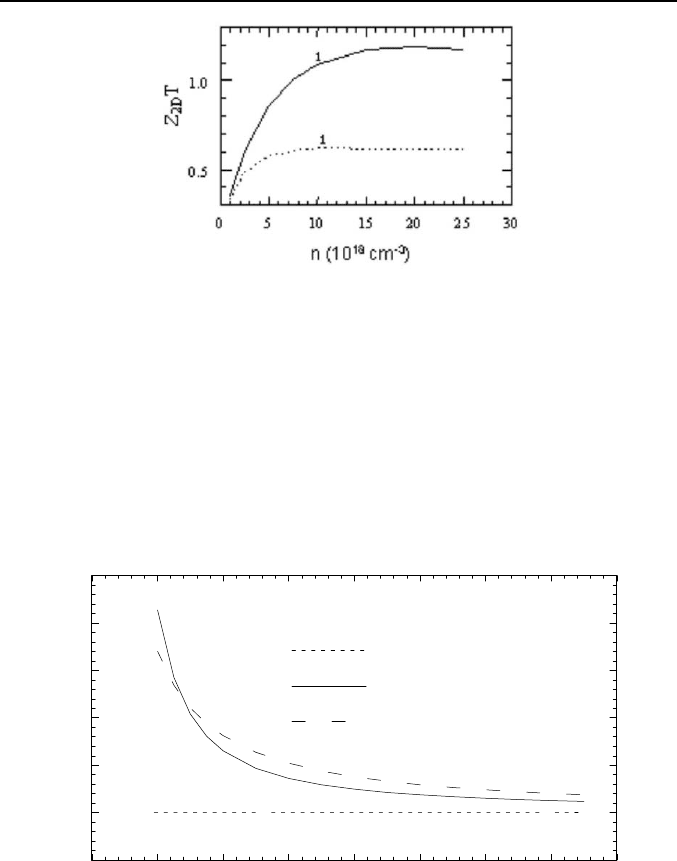
Thermoelectricity of Low-Dimensional Nanostructured Materials 299
Fig. 4. Thermoelectric figure of merit Z
2D
T of PbTe/Pb
1-x
Eu
x
Te as a function of
carrier concentration n for (100) oriented QWs (continuous curve 1) and for (111)
ones (dotted curve 1’). Potential barrier height U = 171 meV, x = 0.073, d = 2 nm,
T = 300 K (after [4]).
In p-type PbTe/PbEuTe quantum well structures the first experimental
demonstration of the principle of low dimensionality in thermoelectricity
obtained in [8] for p-type PbTe/PbEuTe quantum well structures can be
In the context of p-PbTe wells an other low dimensional approach have
been
reveal [9] it was suggested that quantum confinement will lead to the
Fig. 5. Thermoelectric figure of merit of p-type PbTe/Pb
0.927
Eu
0.073
Te quantum well
structures scaled by its bulk value as a function of well width d for two differen
t
scattering mechanisms (on acoustical phonons (DA) and optical phonons (LO)).
0 20406080100120140160
0
1
2
3
4
5
6
DA,
DA,
LO,
ZT
2D
/ZT
3D
d (Å)
U =
∞
U = 141 meV
U =
∞
was obtained. As an illustration in Fig. 5 the first experimental results
reproduced taking into account the finite weight of the barrier.

300 V. G. Kantser
change of the thermoelectric transport from L-type subbands to Σ -type
ones. The latter with higher density of states must be more favorable for the
improvement of thermoelectric properties. This is the case for PbTe where
we have 12 full valleys (energetic minimas) and 12 full ellipsoids of
constant energy in
Σ -points of the Brillouin zone. As a result, the density
of states must be higher and, respectively, the Seebeck coefficient and the
figure of merit must be higher too.
GeSi/Si QW structures are also materials utilized in bulk
thermoelectricity. The modeling of their thermoelectric properties and the
first experimental results indicate that the may have a higher possible figure
merit. It has been also shown that in such structures the phonon scattering
rate is considerably increased and, as a result, the QW in-plane lattice
thermal conductivity is strongly diminished [10]. For the optimization of
the thermoelectric properties of QW structures it is very important to take
into account the prospects of phonon engineering as well [2].ZA lot of
investigations so far has focused on the thermoelectric transport
perpendicular to the layer plane of structures. There are several aspects
related to the study the transport perpendicular to superlattice layer plane
[2]: i) tailoring the density of states using quantum size effects; ii) energy
filtering through thermionic transport; iii) reducing thermal conductivity by
stopping the propagation of some phonon modes; iv) selective scattering of
carriers with high and low energy.
The results obtained with the 1 nm / 5 nm Bi
2
Te
3
/Sb
2
Te
3
p-type
superlattices indicate that the phonon and charge carriers transport can be
tuned to improve ZT [11] by the so-called phonon-blocking/electron-
transmitting mechanism [12]. In the same paper encouraging results have
been also obtained with n-type 1 nm / 5 nm Bi
2
Te
3
/Bi
2
Te
2.83
Se
0.17
n-type
superlattices, indicating ZT values higher than one at 300 K. The reason for
the less-than impressive ZT value of 1.46 at 300 K in n-type
Bi
2
Te
3
/Bi
2
Te
2.83
Se
0.17
superlattices, compared to 2.4 at 300 K in the best p-
type Bi
2
Te
3
/Sb
2
Te
3
superlattices, is their higher thermal conductivity K.
Thermoelectric Wire Nanostructures
General theoretical considerations suggest that, because of their increased
quantum confinement effects, one-dimensional quantum wires could have
an
even larger enhancement in ZT. However, even without quantum

Thermoelectricity of Low-Dimensional Nanostructured Materials 301
confinement effects microwires are of significant importance due to the
following aspects:
(1) the one-dimensional shape of the microwire should be favourable
for
some synthetic textures;
(2) microwires may be convenient for some tiny-dimensional
applications such as natural “thermoelectric wires” taking
advantage of their characteristic shape.
Several mechanisms are combined to enhance ZT in nanowire arrays:
1. strong carrier quantum confinement in each quantum wire resulting
in a δ-function like density of states
2. suppression of phonon scattering
3. strong asymmetry of the energy dependence of the DOS.
Due to the very small effective mass of the charge carriers in Bi and
PbTe-like semiconductors, the effects of reduced dimensionality can be
seen in samples with dimensions of the order of 10 to 50 nm. In addition, it
was shown recently [13] that due to the anisotropy of the electron (hole)
energy ellipsoids, the quantum size effects in cylindrical Bi- like wires are
strongly enhanced. The origin of this effect is related to the peculiarities
arising from the wave propagation of anisotropic carriers - like caustics in
the geometrical optics of light propagation in ellipsoidal resonators.
Recently, the methods and corresponding technological equipment for
the fabrication of an array of Bi nanowires have been developed. Arrays
with wire diameters of 5-200 nm have been obtained by liquid-phase
pressure injection [14], vapour-phase deposition [15] and electrochemical
deposition [16]. Various transport investigations have been carried out to
highlight classical and quantum size effects [17-19]. As a host template
materials porous anodic alumina has been used and even single crystalline
nanowires of two orientations (normal to the (202) and (012) lattice planes)
were fabricated. Figure 6 shows an image of an anodized alumina template
which is filled with bismuth by electrochemical deposition.
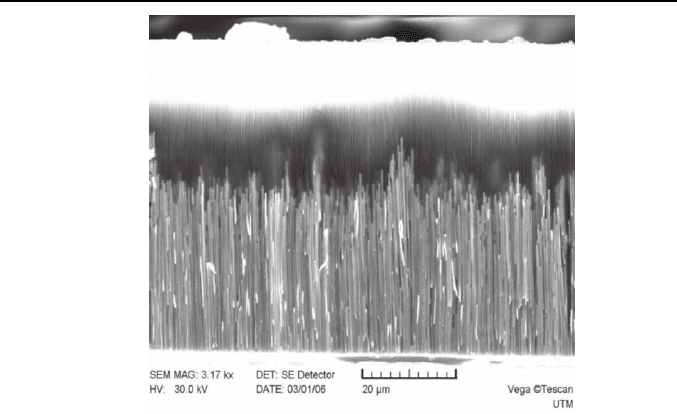
302 V. G. Kantser
Fig. 6. SEM image of Bi nanowire arrays in the alumina template. The wire
diameter is ~ 100 nm.
However, regarding the compatibility of the nanowire array technology
with the conventional technology of micro- and optoelectronic materials
and from the perspective of wire orientations and their doping the nanowire
array fabrication in porous silicon and III-V semiconductors seems to be
more attractive. Investigations in this direction started recently.
Nanowire arrays based on Bi are the most promising systems for re-
engineering the transport properties by making use of the quantum
confinement effect of the anisotropic carriers and size-induced semimetal-
semiconductor phase transitions, which are expected to result in good
parameters for thermoelectric applications [19]. In particular, the anisotropy
of the carrier pockets in Bi is outlined to be one of the key elements for
achieving significantly improved thermoelectric parameters. On the basis of
theoretical investigations, the thermoelectric figure of merit Z
1D
T of Bi
nanowires is expected to increase significantly [19, 20] However, the
measurements of the thermoelectric properties (such as the Seebeck
coefficient and the thermal conductivity as well as a quantitative
explanation of these measurements (and even of existing results on
electrophysical investigations) are more challenging. Only recently, the first
results of the Seebeck coefficient measurements in Bi-wires
nanocomposites have been obtained [21]. The thermoelectric power was
found to increase considerable in Bi-nanowires with diameters less than
10 nm in alumina matrices.
On
the other hand the investigations of the Electric Field Effect (EFE)
on thermoelectric transport in solid state structures have been started

Thermoelectricity of Low-Dimensional Nanostructured Materials 303
recently [22]. In the context of nanowire structures the first theoretical
analysis show that thermoelectric transport and figure of merit can be
engineered by radial EFE [23]. For coaxial cylindrical capacitor
configuration of PbTe and Bi
2
Te
3
nanowire structures was established that
the existence of the transition bipolar-monopolar semiconductor in radial
electric field, differences in carrier masses and mobility can essentially
Fig. 7. Dependence of the Seebeck coefficient for electrons Sn (dash line), holes Sp
(dash dot line) and bipolar Seebeck coefficient S (solid line) on the gate voltage
cylindrical capacitor Bi
2
Te
3
nanowire structures with diameter of 100 nm.
Quantum Dots and Three-Dimensional Nanostructured
Thermoelectric Systems
The most significant improvement of the thermoelectric figure of merit ZT
can be achieved by strongly reducing of the lattice thermal conductivity.
The
effect of phonon confinement on the lattice thermal conductivity in
low-dimensional structures is frequently treated in terms of additional
boundary scattering and the decrease of the phonon mean free path.
However, there is also another approach. When the phonon modes in the
confined structures are modified significantly, the group velocity of these
phonons usually decreases and this can strongly influences ZT [22]. Due to
the specific properties of quantum dot systems both implications of size
-300 -200 -100 0 100 200 300
0
100
200
300
400
500
S
p
S
n
Seebeck coefficient [
µV/K]
Gate voltage [V]
modified the thermoelectric properties (Fig. 7).
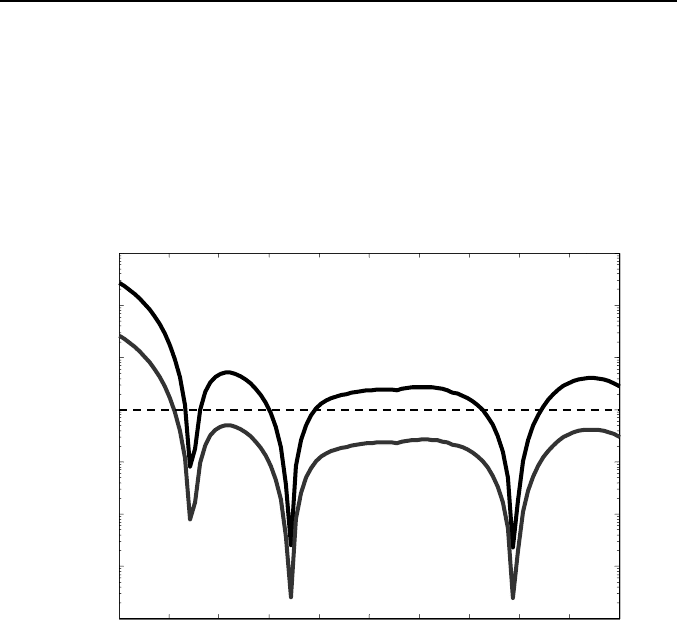
304 V. G. Kantser
effects – classical and quantum – on the characteristics of the phonon
system and the thermal conductivity have been intensively studied over the
last years [24]. In such approach quantum dot systems represent an example
of the abovementioned ‘phonon-blocking electron-transmitting’ [12]
structure with a great potential for thermoelectric applications.
An illustrative result of numerical calculations for a structure that consists
of multiple layers of Si with array of Ge quantum dots separated by wetting
layers and spacers are shown in Fig. 8.
Fig. 8. Figure of merit ZT of Si/Ge quantum dot systems scaled by its bulk value
(ZTexp(Si)=0.05 - 0.06 at 300 K) as a function of Fermi energy for two different
value of thermal conductivity (15 W m
–1
K
–1
and 156 W m
–1
K
–1
respectively).
There the electron and phonon transport modifications due to the space
confinement caused by the mismatch in electronic and thermal properties
between dot and host materials have been taken into account. The analysis
shows that the enhancement of the thermoelectric figure of merit ZT is
mostly due to the significant drop in the lattice thermal conductivity caused
by the acoustic phonon scattering by quantum dots.
To
take advantage of both the superlattices and the nanowires to design
a better thermoelectric system in [26] another variant of nanostructured
quantum dot like systems have been proposed and investigated. The
electronic density of states and the thermoelectric properties of superlattice
nanowires made of various lead salts (PbS, PbSe, and PbTe) have been
investigated as a function of the segment length, wire diameter, crystal
orientation along the wire axis, and the length ratio of the constituent
10
-3
10
-2
10
-1
10
-0
10
1
10
2
10
3
1
4
-0.1-0.2
0.1 0.2
-0.3
Fermi Energy (eV)
ZT
Q
DC
/ZT
B
